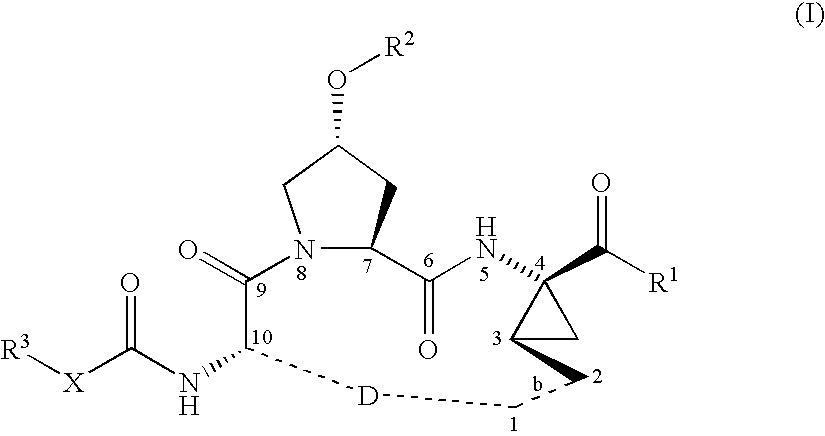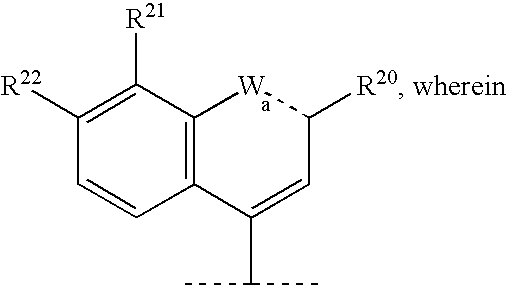Macrocyclic peptides active against the hepatitis C virus
a peptide and macrocyclic technology, applied in the field of compound, can solve the problems of lack of effective immunoglobulin treatment, lack of cellular and humoral immune responses in protecting against hcv infection and disease, and the recommendation of immunoglobulin treatment, so as to inhibit the replication of hepatitis c virus
- Summary
- Abstract
- Description
- Claims
- Application Information
AI Technical Summary
Benefits of technology
Problems solved by technology
Method used
Image
Examples
example 1
Synthesis of INRF12 Brosylate Intermediate
Step 1: Introduction of the Boc-Protecting Group: Synthesis of INRF2
The amino-protection was done with the Boc-protecting-group. INRF 1 (trans-4-hydroxy L-proline) (249.8 g, 1.905 mol) was dissolved in water (375 mL) and 45% sodium hydroxide solution (203 g, 2.286 mol). To ensure good phase transfer, tert-butanol (106 g) was added. In an alternative procedure, acetone was used instead of THF / tert-butanol. The reaction mixture was heated to 50° C. and the anhydride Boc2O (424 g, 1.943 mol), dissolved in THF (425 mL), or acetone, was slowly added. The reaction is exothermic and generates gas (CO2) as the Boc2O was added. If the reaction does not proceed as desired, catalytic amounts of DMAP (2.3 g, 19 mmol) can be added. After the addition of the Boc2O, the reaction mixture was kept 0.5-1 h at 50° C., and the THF was removed by partial distillation. The pH of the remaining solution was adjusted to about pH 3 with concentrated HCl (204 g, 2...
example 1a
Synthesis of Brosylate Intermediate with a Saturated Linker for the Synthesis of Compounds of Table 2
Step A: To brosylate INRF12-Brs (1.0 g, 1.41 mmol, 1 eq.) dissolved in EtOAc (30 mL) was added 5% Rh / Al (300 mg, 30% w / w). The atmosphere was saturated with H2 gas and stirred at RT for 10 h until complete conversion by HPLC analysis. The suspension was filtered through Celite to remove the catalyst and the solvent removed in vacuo to afford a white solid. Purification (SiO2, (1:1) EtOAc / hexanes) afforded after concentration the saturated macrocycle 1A1 (467 mg, 47%) as a white solid.
example 2a
Synthesis of 1-methyl-2-methoxy Aniline (2A2)+
To a solution of 2-methyl-3-nitro anisole (2A1) (5.1 g; 30.33 mmol; requires ˜30 min. to dissolve) in absolute ethanol (85 mL) was added 10% Pd / C catalyst (500 mg). The solution was hydrogenated under a hydrogen filled balloon at atmospheric pressure and room temperature for 19 h. The reaction mixture was filtered through a Celite pad, rinsed and evaporated to dryness to obtain the compound 2A2 as a deep mauve oil (4.1g; 29.81 mmol; 98% yield).
MS 137 (MH)+. Reverse Phase HPLC Homogeneity @ 220 nm (0.06% TFA; CH3CN:H2O): 99%.
PUM
| Property | Measurement | Unit |
|---|---|---|
| Fraction | aaaaa | aaaaa |
| Fraction | aaaaa | aaaaa |
| Temperature | aaaaa | aaaaa |
Abstract
Description
Claims
Application Information
 Login to View More
Login to View More - R&D
- Intellectual Property
- Life Sciences
- Materials
- Tech Scout
- Unparalleled Data Quality
- Higher Quality Content
- 60% Fewer Hallucinations
Browse by: Latest US Patents, China's latest patents, Technical Efficacy Thesaurus, Application Domain, Technology Topic, Popular Technical Reports.
© 2025 PatSnap. All rights reserved.Legal|Privacy policy|Modern Slavery Act Transparency Statement|Sitemap|About US| Contact US: help@patsnap.com



